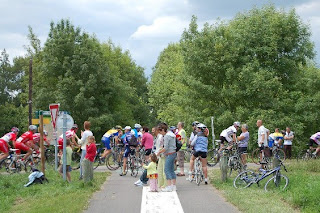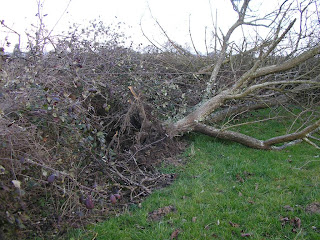 In this area it is not uncommon that villages like Bonnay set out organised walks or cycle trips, whereby these randonnées often carry poetic names like “jonquilles” (daffodils) or “jouvence” (source, fountain). We decided to follow the signs, but at some stage the signs disappeared, and we did not get any wiser. Some years later - by then we had made some friends in that area - we found out that those signs were put up in spring, pointing towards areas in the woods where wild daffodils flowered. This spring (spring had literally just broken out, and that is how winter ends here) we went over to see our friends, and noticed the “jonquilles” signs. Our friends told us, what a good place was to look for these daffodils, and last Saturday we took the camera, got into the car and drove off to the woods around Bonnay in search of the French equivalent of the Dutch bulb-fields. When we arrived there, there was hardly a car to be seen on the grass field near the forest. We were obviously too early; one could see the daffodils, and plenty of them, but there were no flowers yet. Anyway, we had a pleasant walk, and decided to come back in a couple of days. Last Wednesday, it was beautiful weather, we went out to the wood again.
In this area it is not uncommon that villages like Bonnay set out organised walks or cycle trips, whereby these randonnées often carry poetic names like “jonquilles” (daffodils) or “jouvence” (source, fountain). We decided to follow the signs, but at some stage the signs disappeared, and we did not get any wiser. Some years later - by then we had made some friends in that area - we found out that those signs were put up in spring, pointing towards areas in the woods where wild daffodils flowered. This spring (spring had literally just broken out, and that is how winter ends here) we went over to see our friends, and noticed the “jonquilles” signs. Our friends told us, what a good place was to look for these daffodils, and last Saturday we took the camera, got into the car and drove off to the woods around Bonnay in search of the French equivalent of the Dutch bulb-fields. When we arrived there, there was hardly a car to be seen on the grass field near the forest. We were obviously too early; one could see the daffodils, and plenty of them, but there were no flowers yet. Anyway, we had a pleasant walk, and decided to come back in a couple of days. Last Wednesday, it was beautiful weather, we went out to the wood again. Once we entered the wood we realised how much damage can be caused by a horde of “nature lovers” in a relatively short period of time. Where once daffodils had flowered, it looked like a pitch where a number of gladiators had staged a fight. The only flowers that had escaped the pillage, were hidden under the thorny branches of a bramble bush. The few photographs I managed to take are of the daffodils that could not be picked without cutting open your hands. Anyway, it looks like if I ever would like to see a field of daffodils in full glory, I will have to go back to the Netherlands, to admire them in or around Keukenhof....
The website of La Tuilerie de Chazelle





